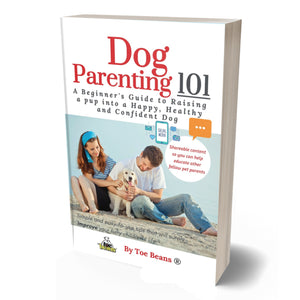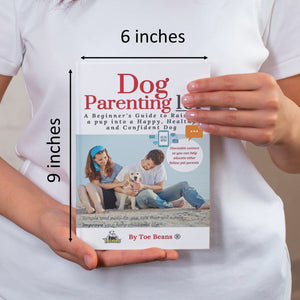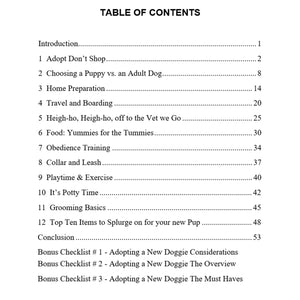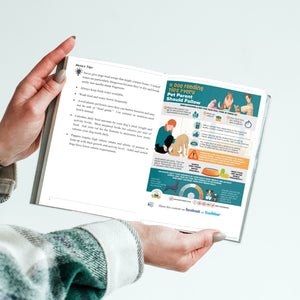Your Cart is Empty




Dog Books | Dog Parenting 101 | Paperback Format
A BEGINNER'S GUIDE ON HOW TO RAISE A PUP INTO A HAPPY, HEALTHY, & CONFIDENT DOG BY TOE BEANS®
$12.80
🚚 FREE Shipping on all orders
Are you planning on growing your family? Thinking of bringing in a furry family member? A dog maybe? Perhaps you are a first-time dog parent? Or maybe you are planning on providing some temporary foster care for dogs?
Whether you're an experienced pet parent or a rookie, you will find this must-have guide very useful. This handy 50-page easy-to-read book contains more than 20 years of pet parenting experience and countless hours of research on how to raise a dog.
Scroll down to learn more about Dog Parenting 101, or check out other cat and dog 101 book titles. Available in both eBook and paperback.
Secure checkout powered by Trustedsite.
Why Dog Parenting 101?

MISSION DRIVEN
At toe beans® we believe that educated pet parents make better decisions for their fur children.
Bringing this book to you is an important building block of the toe beans mission to improve the life of every fur child via pet parent education.

DOWNLOADABLE CHECKLISTS
This simple guide will equip pet parents with an instructive, organized, and trackable step-by-step approach to integrating a new dog into their family. Every checklist can be downloaded and printed from our website.

GREAT FAMILY READ
This dog parenting guide is sassy, entertaining and speckled with humor. Tips sections and checklists provide a framework for engaging family members in the loving care of your fur children.

GET IT FOR FREE
You can get any of the books in our pet parents’ dog and cat book series for free. Both the eBook and the paperback versions of Dog Parenting 101 are FREE with the purchase of eligible product bundles. Scroll down to the “Get it for Free” section for instructions.

IN FULL COLOR
This 58-page dog parenting guide is filled with beautiful colorful pictures and one-click social media shareable educational illustrations.
About Dog Parenting 101
Written at an 8th-grade reading level, this 12-chapter dog parenting guide is intended for the beginner dog parent.
While amazingly simple, dog parenting 101 is also comprehensive enough to cover the basics - and a little more - about dog parenting.
From how to choose the right pup for your family, to how to prepare your home for the new arrival, to making sure your dog enjoys every vet visit. I‘ve got you covered.
You’ll also learn about making food selections and best practices for feeding your dog. The book also teaches you what you can expect for your regular veterinary care and key tips for a successful vet visit.
At the end of this book, we wrap everything up with three useful checklists every pet parent should have on hand.
Happy reading!
Who Should Read Dog Parenting 101?
Dog Parenting 101 May Be a Great Read For You If:
✔️ You are planning on becoming a new dog parent
✔️ You're a new dog mom or dad
✔️ You simply love dogs and want to brush up on your dog parenting skills
✔️ You're interested in temporary foster care for dogs
✔️ You're an animal rescue volunteer
✔️ You have a young or teenage child wanting a dog, this book will be a great educational tool
✔️ You happen to find yourself in a situation where you are taking care of an orphaned puppy
Dog Parenting 101 may not be a good read for you if you’ve already raised your dog to adulthood or if you are an experienced dog parent.
The Dog & Cat Pet Parent Book Series by Toe Beans
✔️ Dog Parenting 101 is part of the Pet Parents 101 Book series, a fun, educational, and practical easy-to-read 12-book series on dog and cat care basics intended for the beginner pet parent.
✔️ An important building block of the toe beans mission, the series is intended for every pet parent, pet care giver, and cat & dog lover wishing to learn the basics or simply polish their pet care skills and improve the life of their furry child/foster/friend.
✔️ Written for all ages, every book in the series makes for a great opportunity to get the entire family involved in the loving care of furry family members.
✔️ Want it for FREE? No problem. All the books in our pet parents' dog and cat book series are free with eligible product bundles.
✔️ Fun for all ages from young children to adults.
✔️ At toe beans we believe in the power of love and joy animals bring to our lives. In return, we are devoting a lot of resources to ensure this series (still in the making) makes a small contribution to improving your furry children/friends' lives.
In Paperback & eBook Versions
✔️ Dog Parenting 101 is conveniently available in paperback and eBook.
✔️ Both versions are FREE with the purchase of eligible product bundles.
✔️ Whether you're an old-school book reader or prefer to read on your computer, tablet, or phone, we’ve got you covered.
✔️ Check out the advantages and disadvantages of each format in the chart.
✔️ A cool feature of the paperback option is that they can be autographed upon request and at no cost.
✔️ A short 100 words can also be handwritten. This unique feature makes for a great gift for somebody that has made the wonderful decision to become a dog parent for the first time.
Want Dog Parenting 101 for Free?
How to get the eBook version for FREE:
✔️ Purchase our Playing it Safe bundle and save up to 19%:
- Your selection of any EarthCare Bio-Rope toy
- USA-made, BPA free dog & cat wet-food saving can lids
- Dog Parenting 101 eBook
(Save time - click here to automatically add all 3 items to your cart.)
✔️ Hit checkout then enter coupon code: DPE to make the eBook FREE.
Rather get the paperback version instead?
✔️ Purchase our Playing it Safe PLUS bundle and save up to 21%:
- Your selection of any EarthCare Bio-Rope toy
- USA-made, BPA free dog & cat wet-food saving can lids
- Any Momma Knows Best USDA Organic Moisturizing Balm
- Dog Parenting 101 - paperback
(Save time - click here to automatically add all 4 items to your cart.)
✔️ Hit checkout then enter coupon code: DPP to make the eBook FREE.
About the Author
K. Marie Alto is a fur mom, wife, wannabe writer, blogger, and the co-founder and Chief Fur Children Happiness Officer at toe beans.
With over 20 years of experience as a pet momma, K. Marie loves sharing her personal journey and experience as a pet parent via her blog and Facebook page where she currently has more than 30K followers (@furrytoebeans) and counting.
Driven by her mission to improve the lives of every fur child, K. Marie dreams of a world with happier, more active, healthier, and longer living fur children in every home.
She believes that safety of pet products should be every pet parent’s #1 priority. Purchasing products that are truly safe for dogs and cats can be a challenge in the wild west of the pet products industry. That’s why she is committed to educating pet parents to make smart purchasing decisions on behalf of their beloved fur children.
Toe Beans is a US based ecommerce direct to consumer pet products online boutique.
PET PARENT EDUCATION
Dog Parenting FAQs
-
Choosing the right dog breed for your lifestyle is important to ensure a harmonious match. Consider factors such as energy level, size, exercise requirements, and temperament. Research different breeds and assess whether their needs align with your lifestyle, living situation, and available time for exercise and training. Consulting with breeders, shelters, or rescue organizations can provide valuable insights into finding the right breed for you.
-
To welcome a new dog into your home, you'll need some essential supplies. These include food and water bowls, a comfortable bed, appropriate toys, a leash and collar or harness, identification tags, grooming tools, and dog-specific cleaning supplies. Additionally, ensure you have a secure and safe space for your dog to rest and explore.
-
Potty training is an essential part of dog parenting. Establish a consistent routine by taking your dog outside frequently, especially after meals, playtime, and waking up. Use positive reinforcement, such as treats and praise, when your dog eliminates in the appropriate spot. Consistency, patience, and avoiding punishment are key to successful potty training. If you encounter challenges, consider seeking guidance from a professional dog trainer.
-
Choosing the right food for your new dog is crucial for their health and well-being. Choose high-quality dog food that is appropriate for your dog's age, size, and breed. Always consult your veterinarian for dietary recommendations specific to your dog's needs. Follow feeding guidelines on the food packaging and monitor your dog's weight and overall condition to ensure they are receiving proper nutrition.
-
Regular exercise is essential for a dog's physical and mental well-being. The amount of exercise required varies based on the breed, age, and health of your dog. As a general guideline, aim for at least 30 minutes to 1 hour of exercise daily. This can include walks, playtime, interactive games, or other activities that suit your dog's needs. Consult your veterinarian to determine the appropriate exercise routine for your specific dog.
-
Socialization is crucial for a well-rounded dog. Introduce your dog to various environments, people, and other animals in a positive and controlled manner. Start with calm and friendly introductions, gradually exposing your dog to new experiences. Enroll in obedience classes or seek guidance from a professional dog trainer to help with socialization and basic training.
-
Training your dog to obey basic commands enhances communication and strengthens your bond. Start with simple commands like sit," "stay," and "come." Use positive reinforcement techniques such as treats, praise, and rewards when your dog responds correctly. Consistency, patience, and short training sessions are key to successful training. Consider attending obedience classes or working with a professional dog trainer for additional guidance.
-
Preventing behavior problems involves consistent training, positive reinforcement, and providing appropriate outlets for your dog's energy and instincts. Ensure your dog receives regular exercise, mental stimulation, and social interaction. Set clear boundaries and rules, and avoid reinforcing unwanted behaviors. Address any behavior concerns early on and seek professional guidance if needed.
-
Grooming your dog at home involves regular brushing, bathing, nail trimming, and ear cleaning. Use appropriate grooming tools and products for your dog's breed and coat type. Introduce grooming gradually, using positive reinforcement and rewards. If you're unsure about specific grooming techniques or have concerns, consult professional groomers or veterinarians for guidance.
-
Maintaining your dog's dental hygiene is important for their overall health. Brush your dog's teeth regularly using a dog-friendly toothpaste and a toothbrush designed for dogs. Gradually introduce tooth brushing, starting with small steps and positive reinforcement. Additionally, provide dental chews or toys that promote oral health. Regular dental check-ups with your veterinarian are also recommended.
-
Vaccinations are essential to protect your dog from contagious diseases. Basic vaccinations for dogs include rabies, distemper, parvovirus, and adenovirus. Follow your veterinarian's vaccination schedule and recommendations based on your dog's age, lifestyle, and potential exposure to certain diseases. Regular booster shots are necessary to maintain immunity.
-
Regular veterinary care is important to monitor your dog's health and prevent potential issues. As a general guideline, schedule annual wellness exams for your dog, which may include vaccinations, parasite prevention, dental check-ups, and overall health assessments. Older dogs or those with specific health conditions may require more frequent visits. Consult your veterinarian for personalized recommendations based on your dog's needs.
-
Create a safe environment for your dog by dog-proofing your home and yard. Remove hazardous substances, secure electrical cords, and keep toxic plants out of reach. Ensure your yard is securely fenced to prevent escapes and provide adequate shade and shelter. Avoid leaving your dog unattended in potentially dangerous areas, such as balconies or swimming pools.
-
Some dogs may experience anxiety or fear in certain situations. Create a calm and predictable environment for your dog, providing them with a designated safe space. Use positive reinforcement techniques, such as treats, toys, or soothing music, to help alleviate anxiety. Consult with a professional dog trainer or veterinarian for behavior modification techniques or potential use of anxiety-reducing supplements or medications.
-
Introducing your dog to new people and animals should be done gradually and in a controlled manner. Allow your dog to approach at their own pace, using positive reinforcement and rewards for calm and friendly behavior. Avoid overwhelming or forced interactions. Consult a professional dog trainer for specific techniques and guidance on proper introductions.
-
Chewing is a natural behavior for dogs, but it's important to redirect it to appropriate items. Provide your dog with a variety of chew toys that are safe and suitable for their size and chewing style. Supervise your dog, especially during the initial stages, and redirect their chewing to the appropriate toys. Proper exercise, mental stimulation, and training can also help prevent destructive chewing.
-
When traveling with your dog, ensure their safety and comfort. Use a secure and well-ventilated crate or a harness and seatbelt attachment for car travel. Plan regular rest stops for exercise, bathroom breaks, and hydration. Carry essential supplies, including food, water, medication, identification tags, and a familiar blanket or toy. Check for pet-friendly accommodations and airline policies in advance.
-
Introduce your dog to new experiences and environments gradually to prevent overwhelming or fearful reactions. Start with low-stress situations and gradually expose them to new sounds, smells, people, and environments. Use positive reinforcement and rewards to create positive associations. Seek professional guidance if your dog exhibits extreme fear or anxiety in new situations.
-
Mental stimulation is important for a dog's overall well-being. Engage your dog in interactive games, puzzle toys, and training sessions to keep their mind active. Provide opportunities for sniffing, exploring, and problem-solving. Regular exercise, socialization, and novel experiences also contribute to mental stimulation. Tailor activities to your dog's abilities and preferences, and always prioritize their safety and enjoyment.











